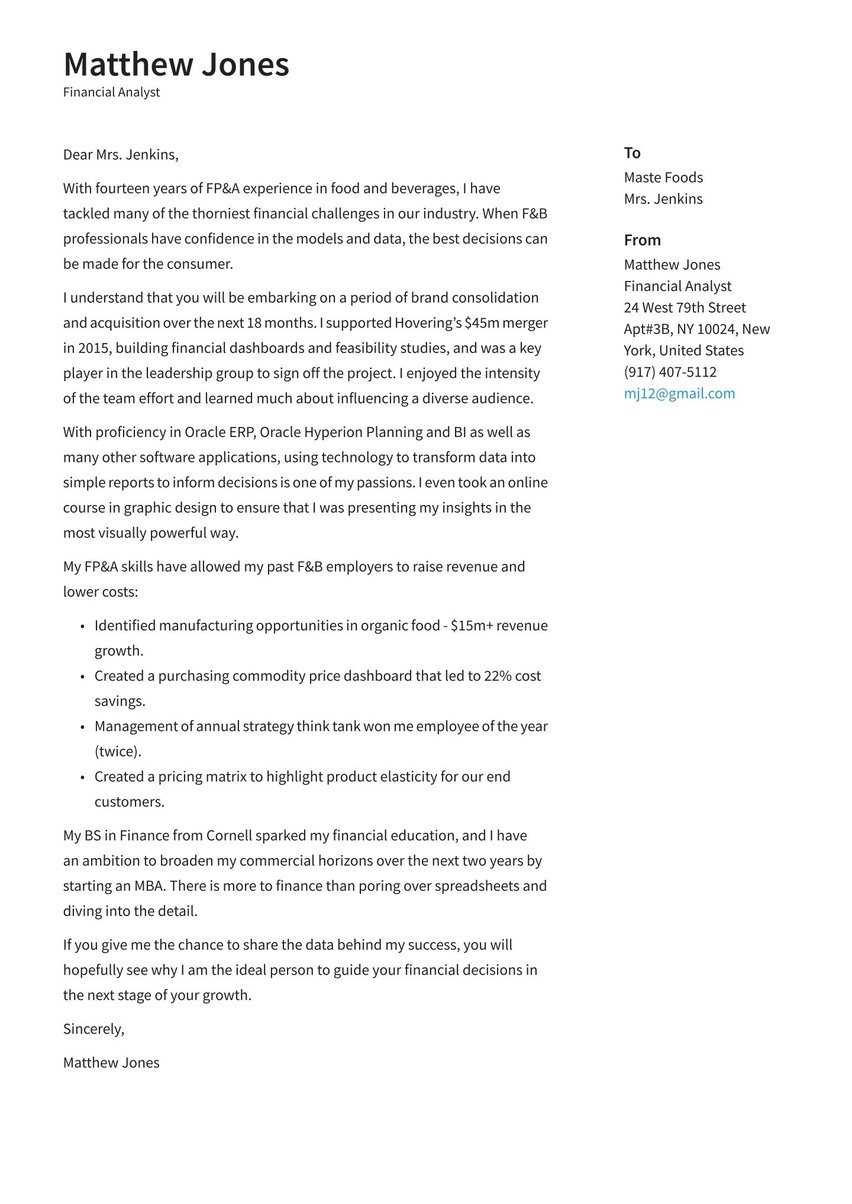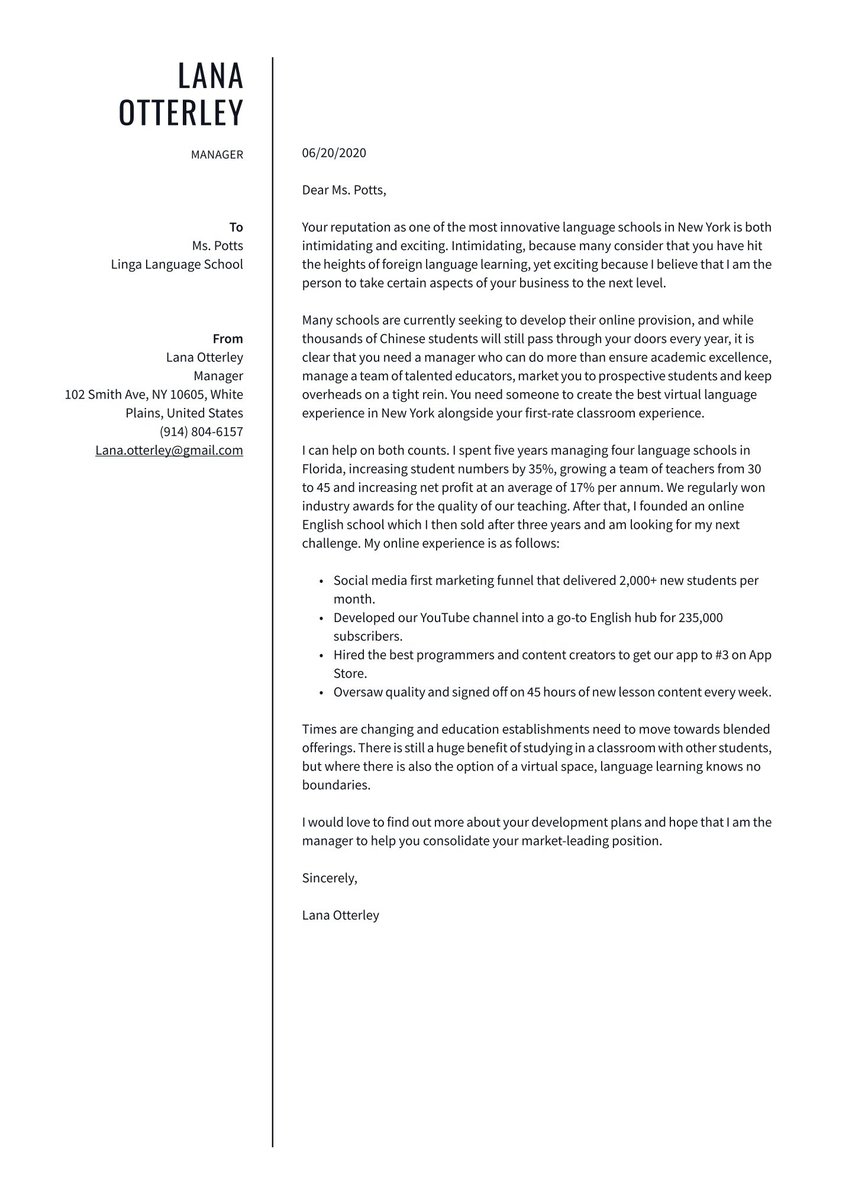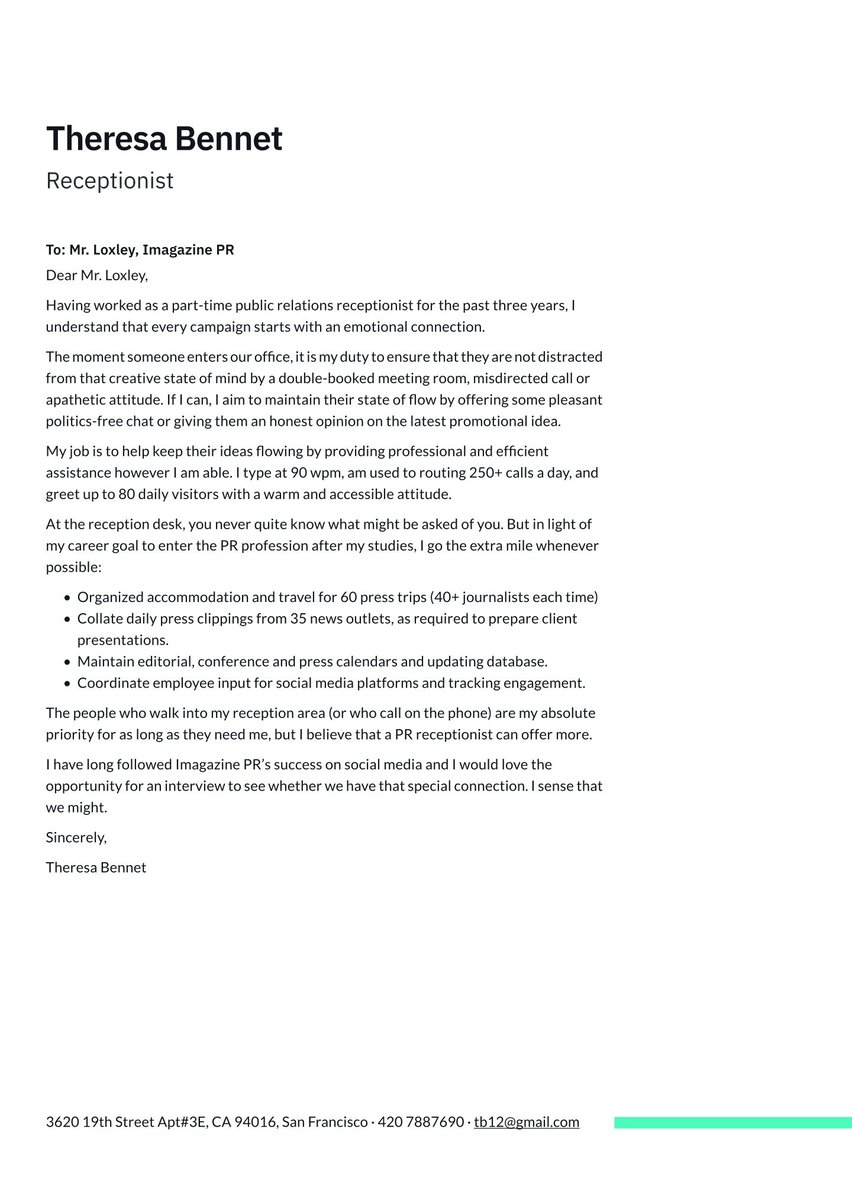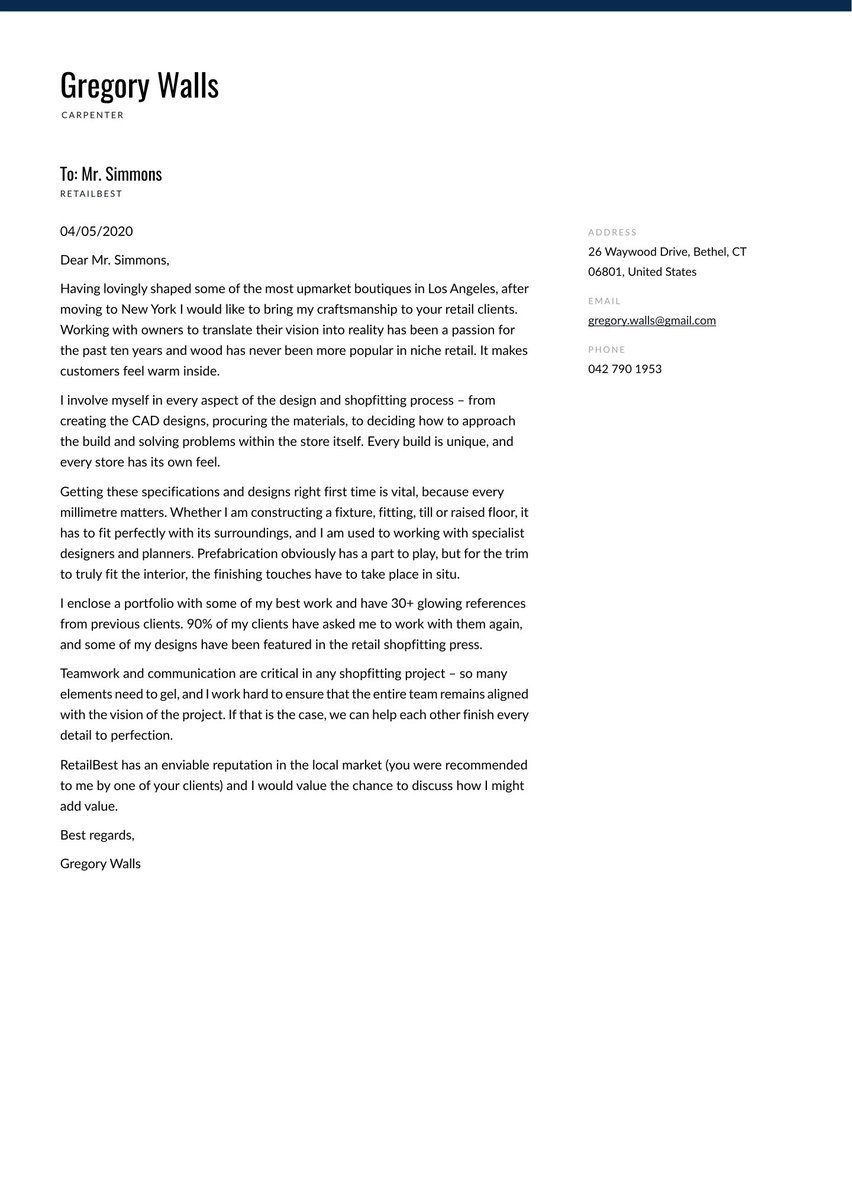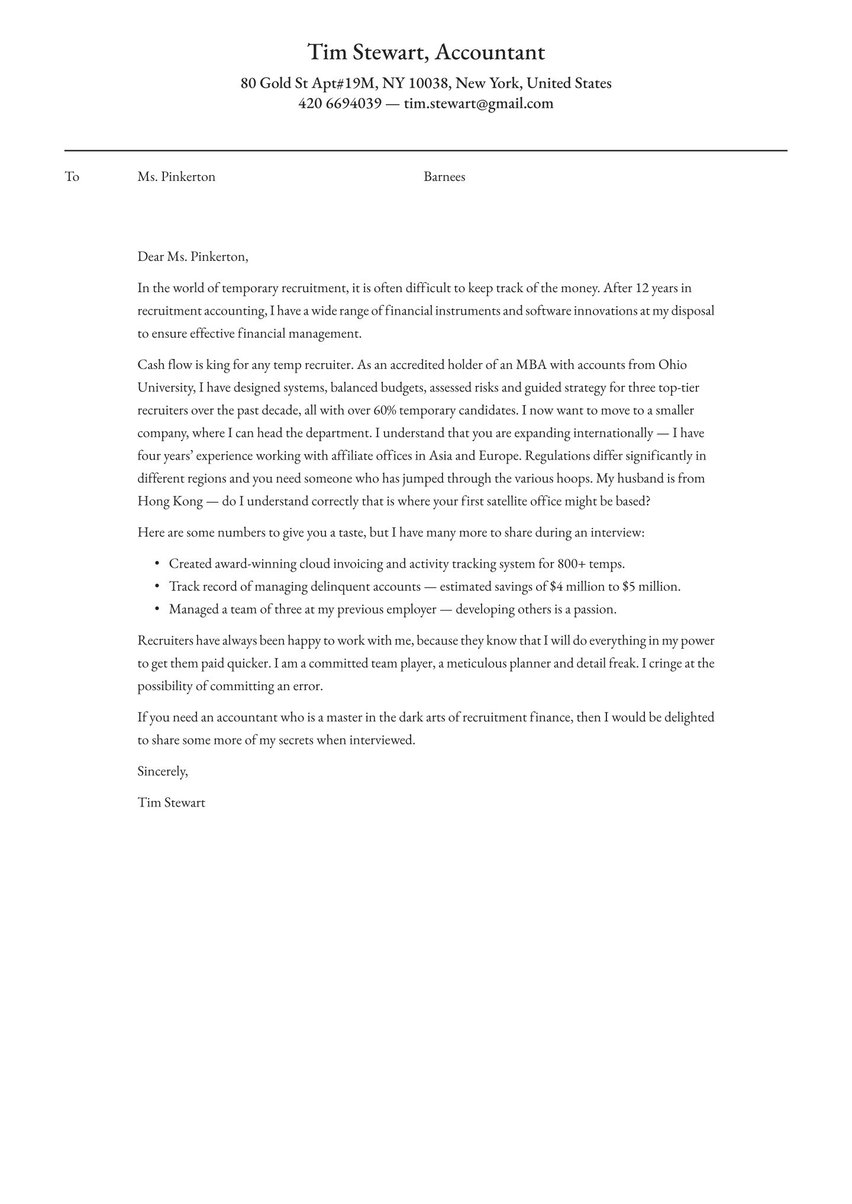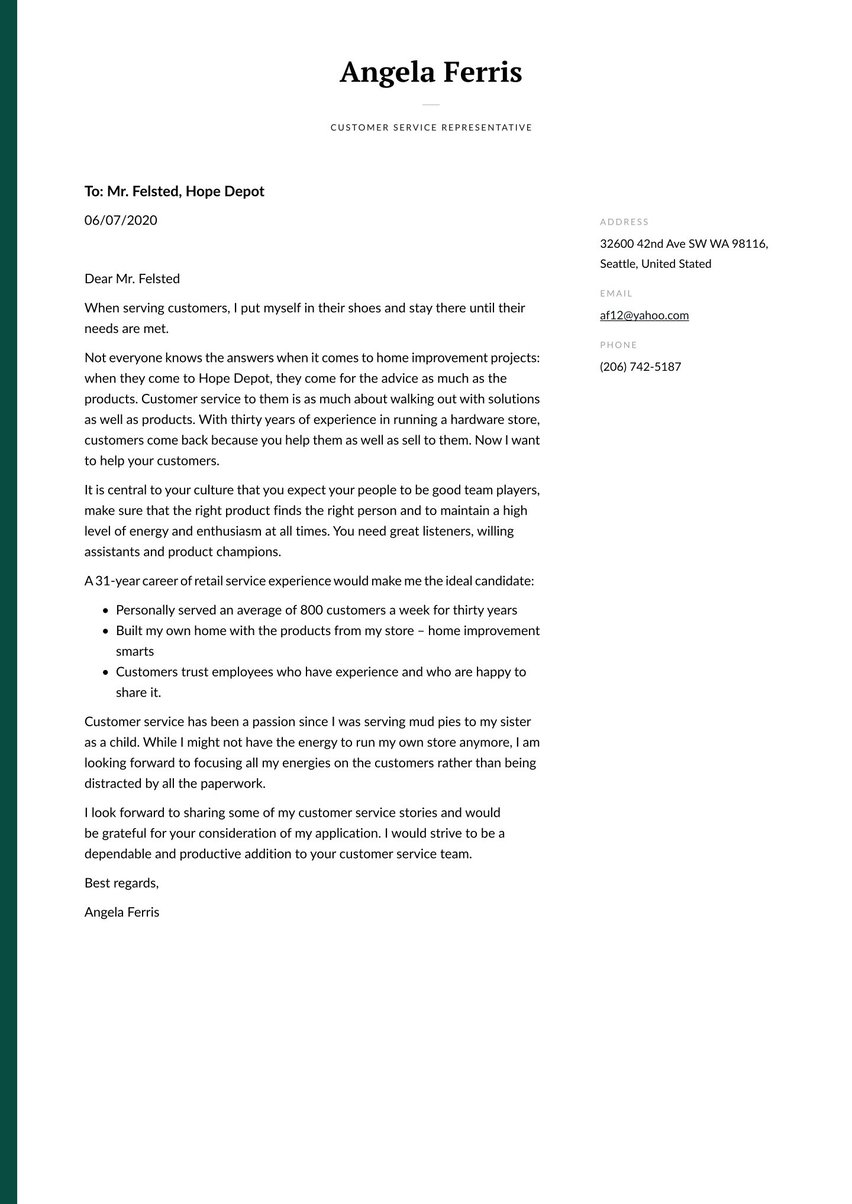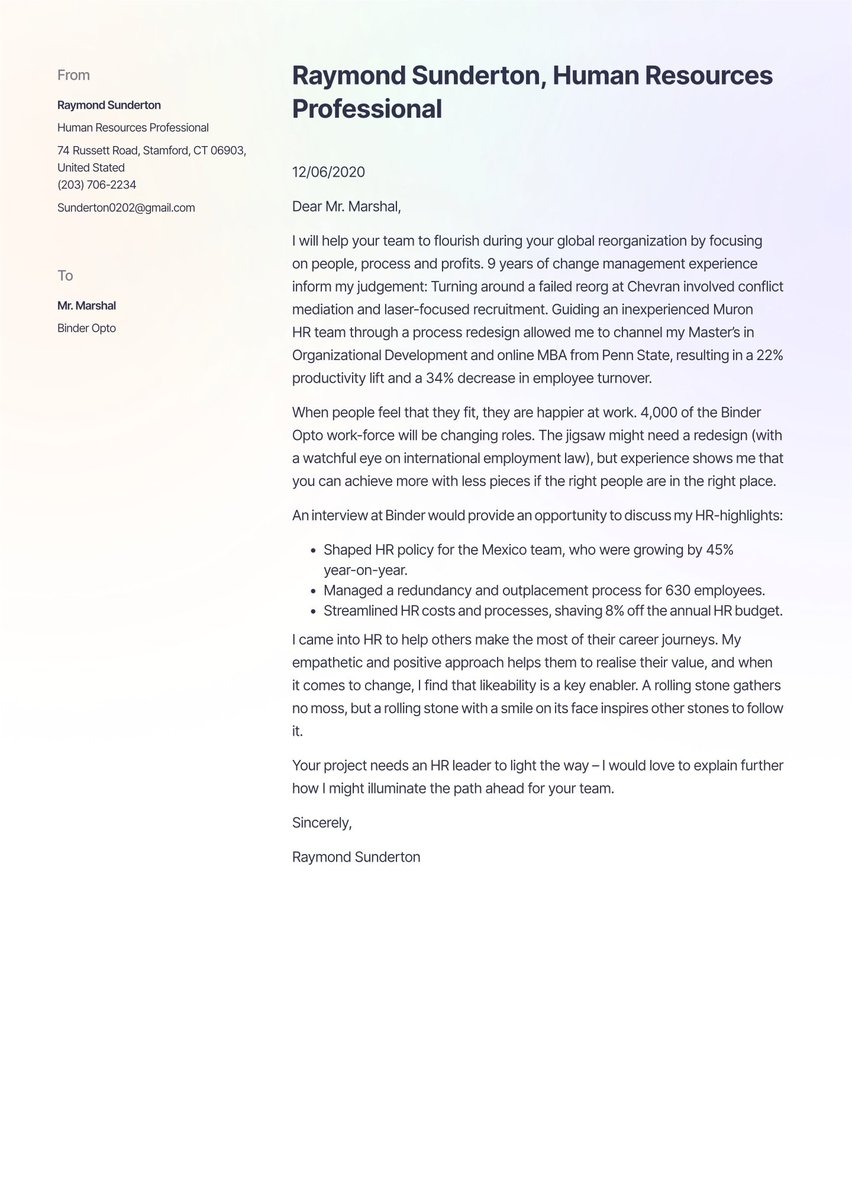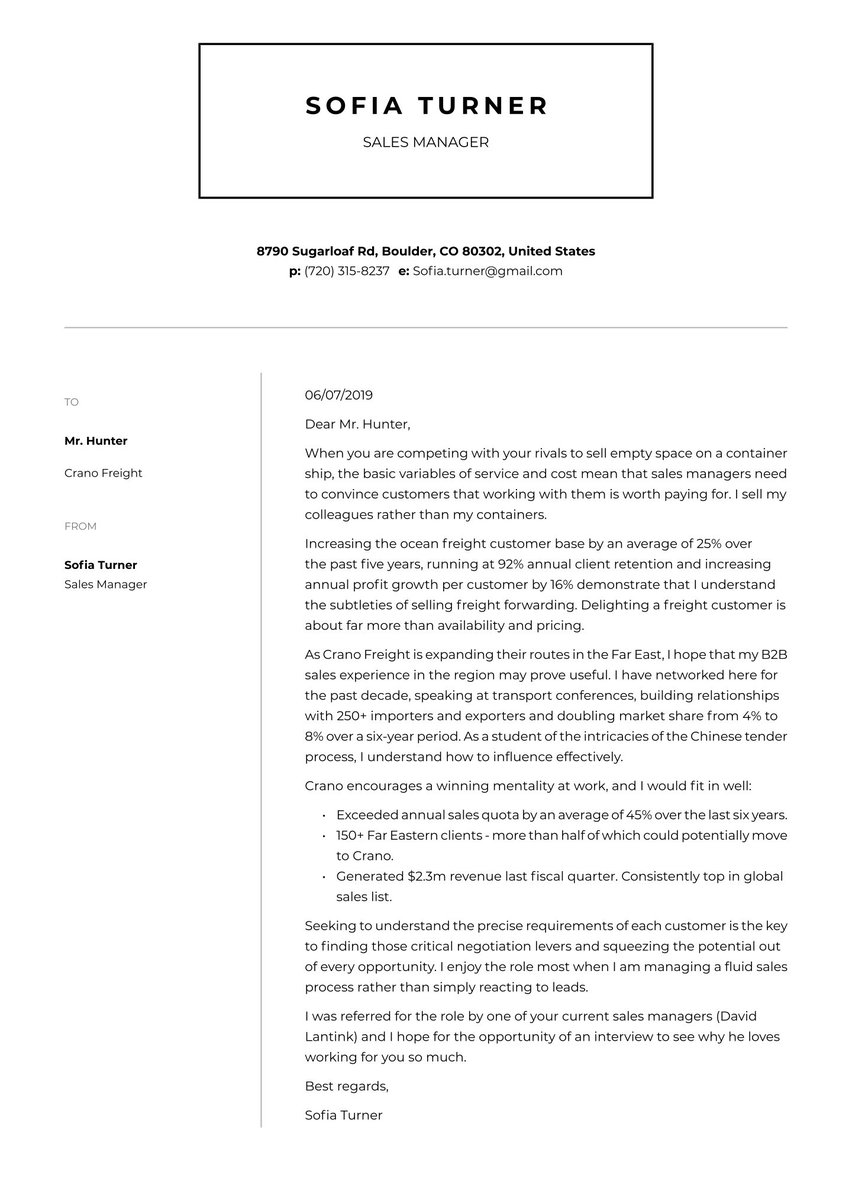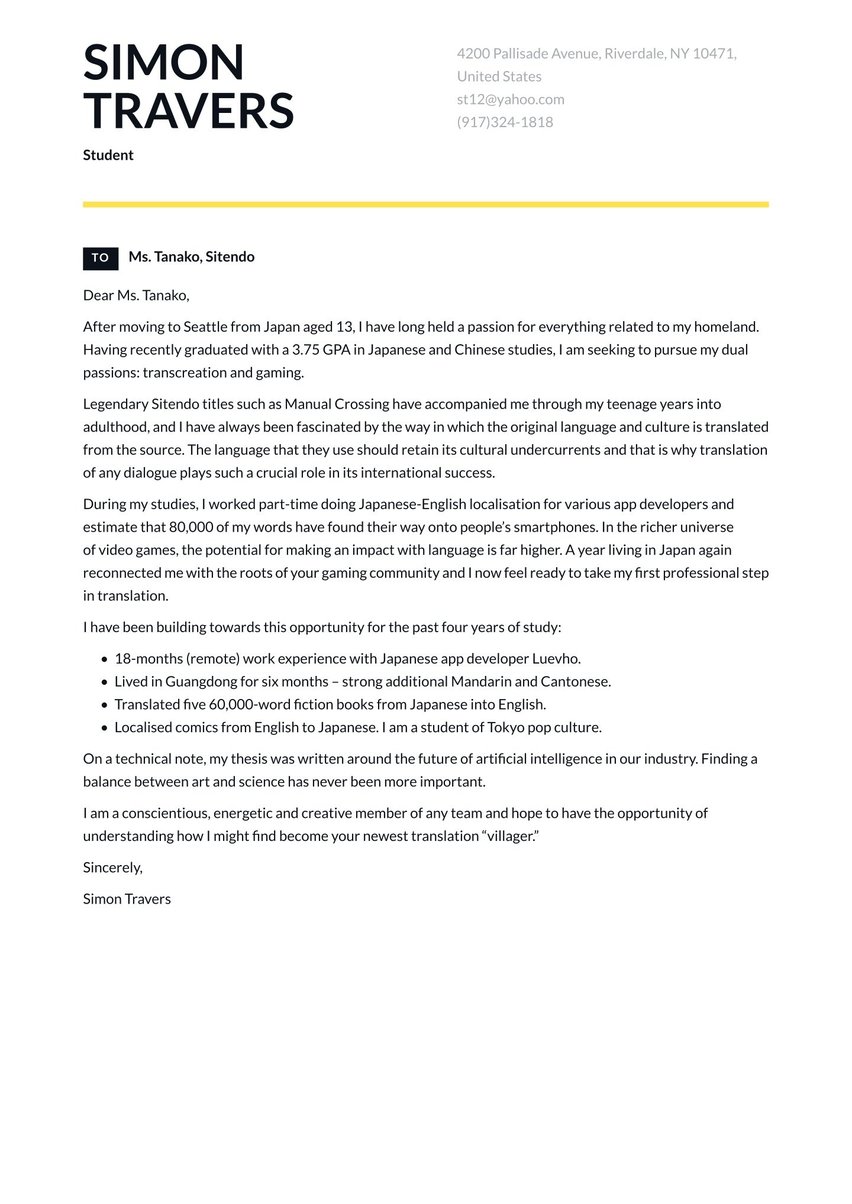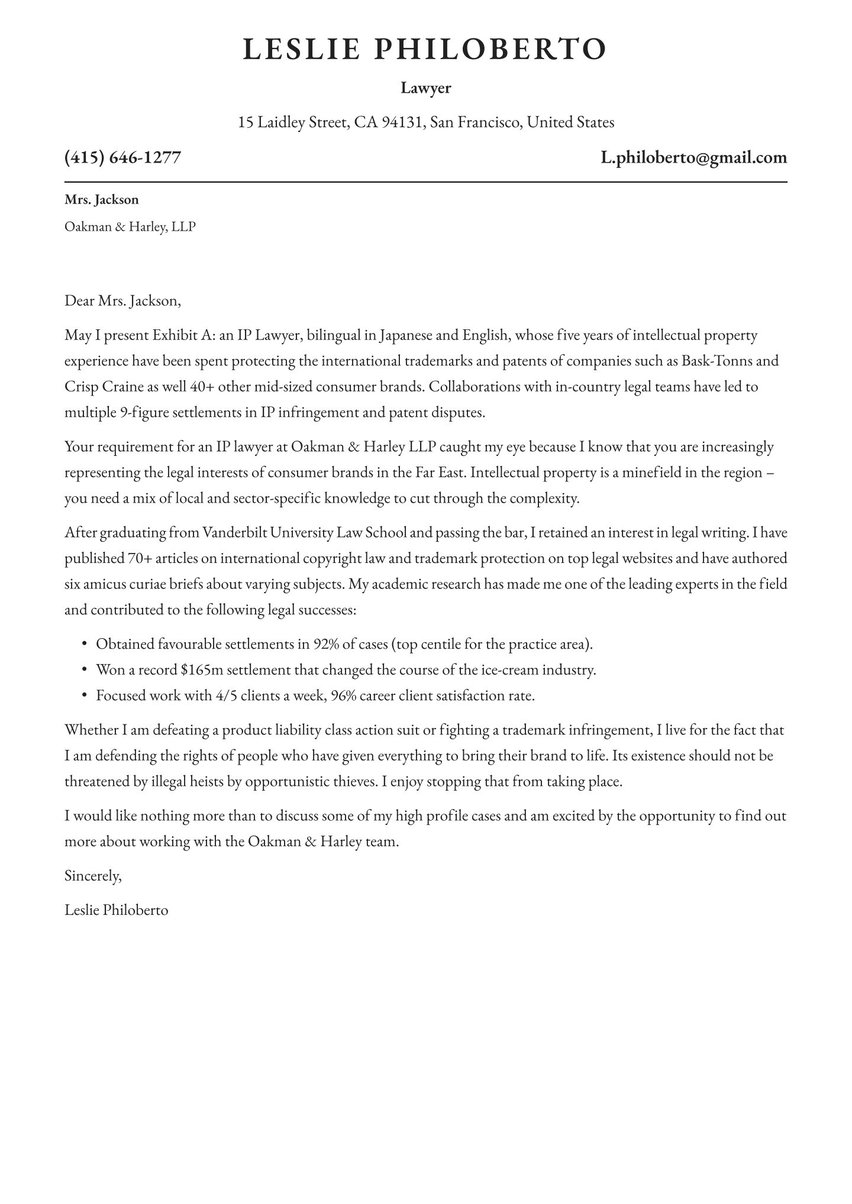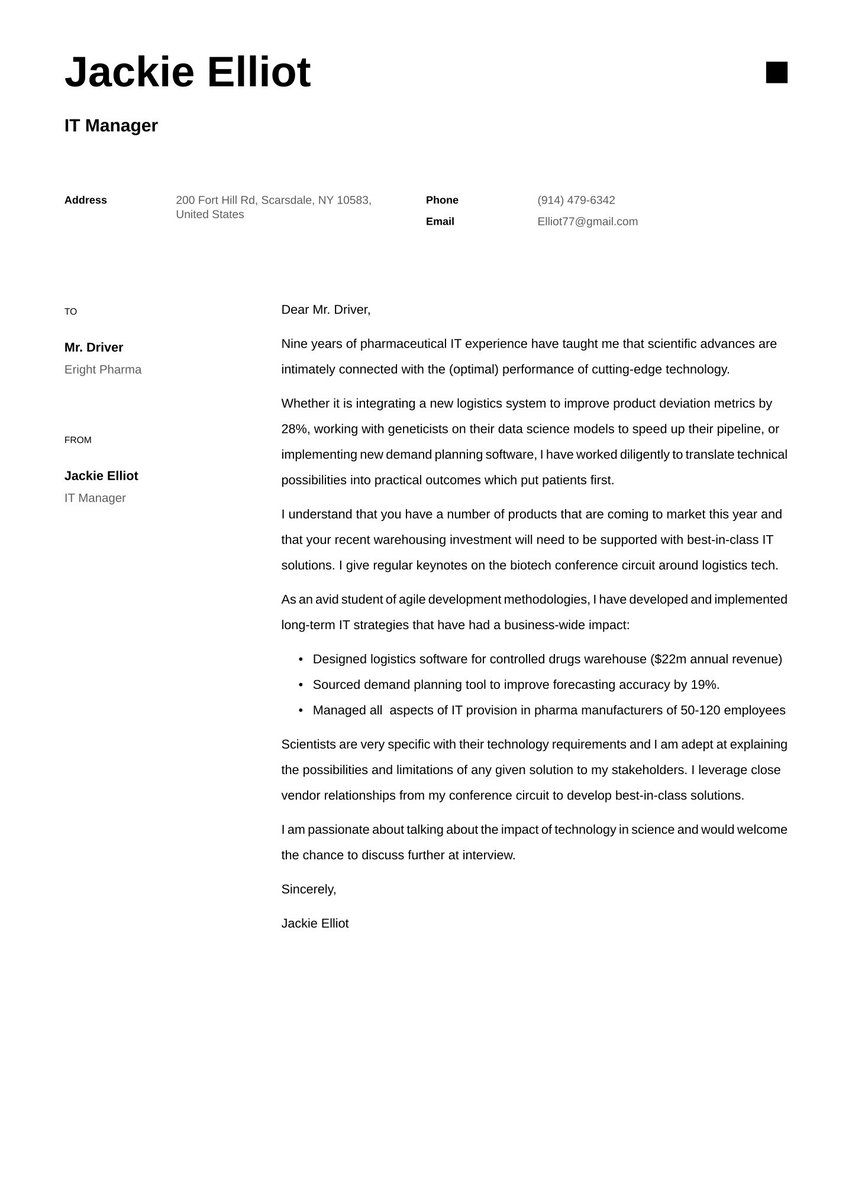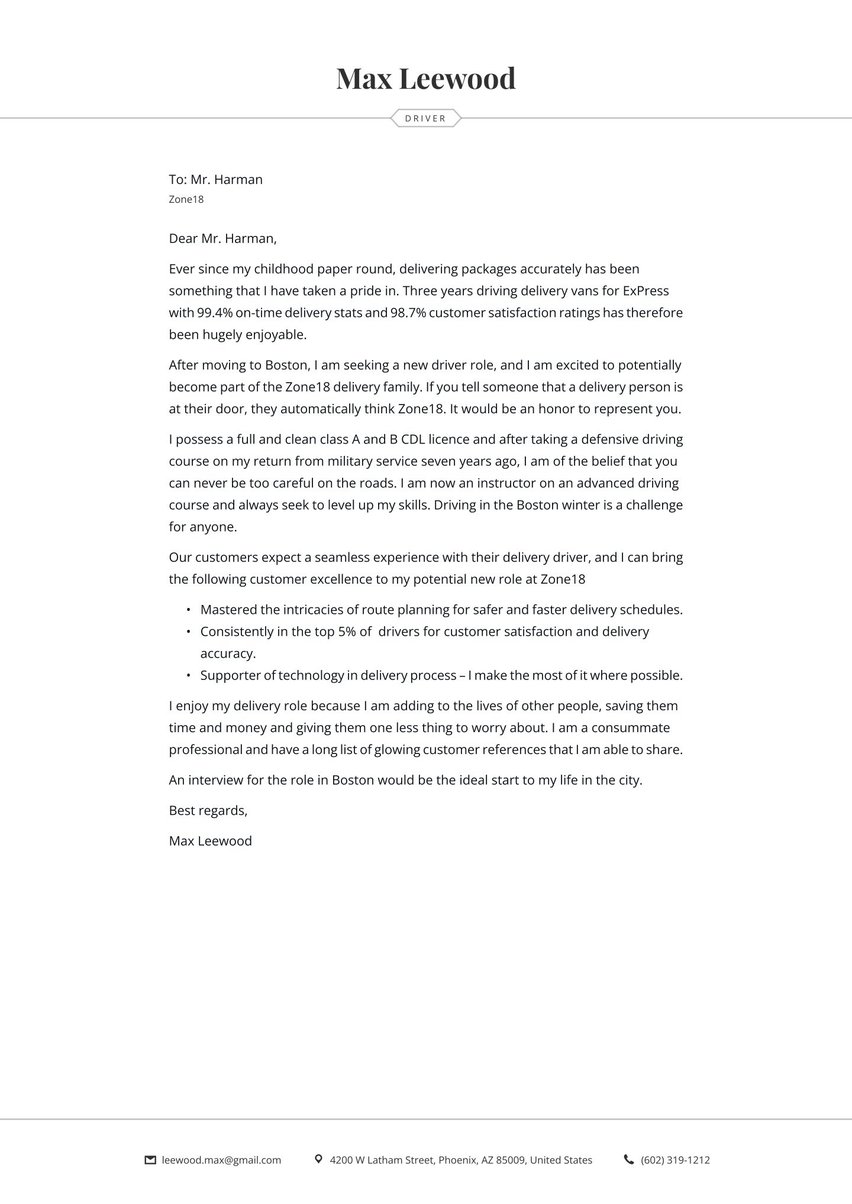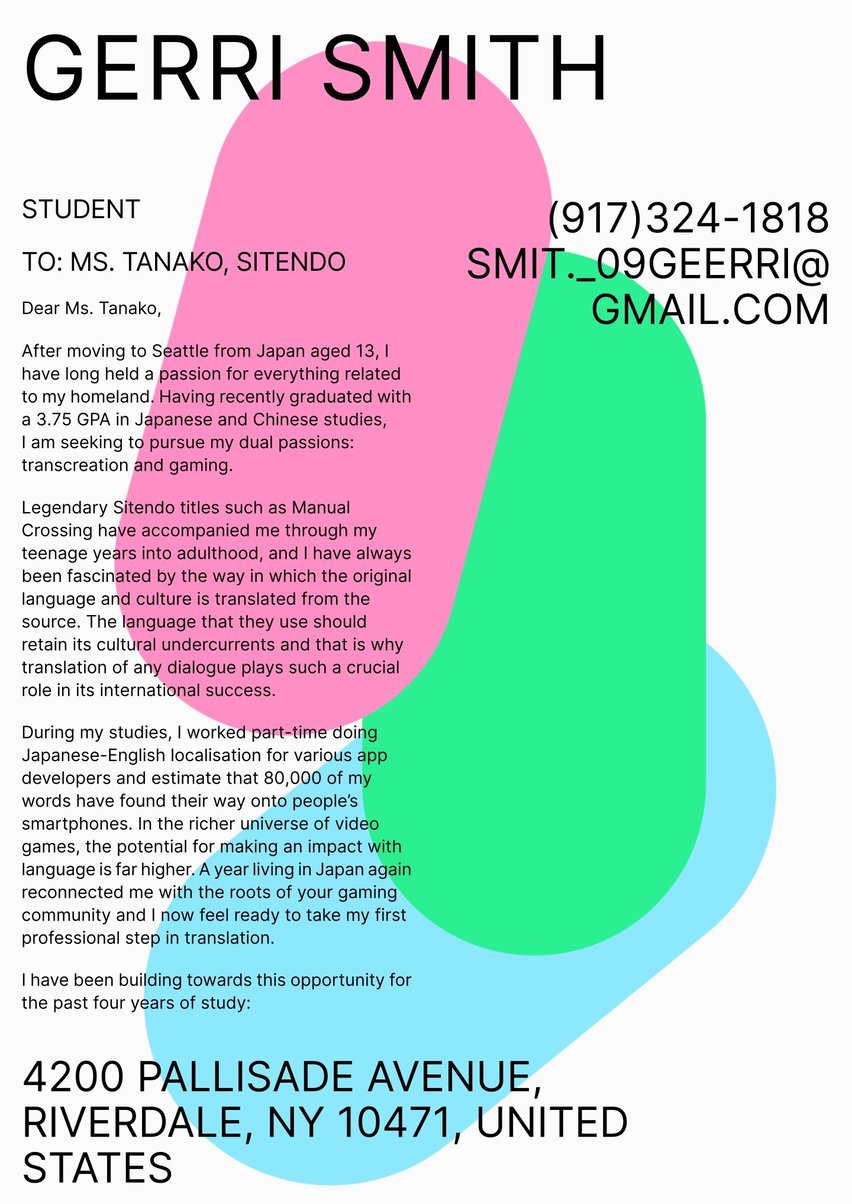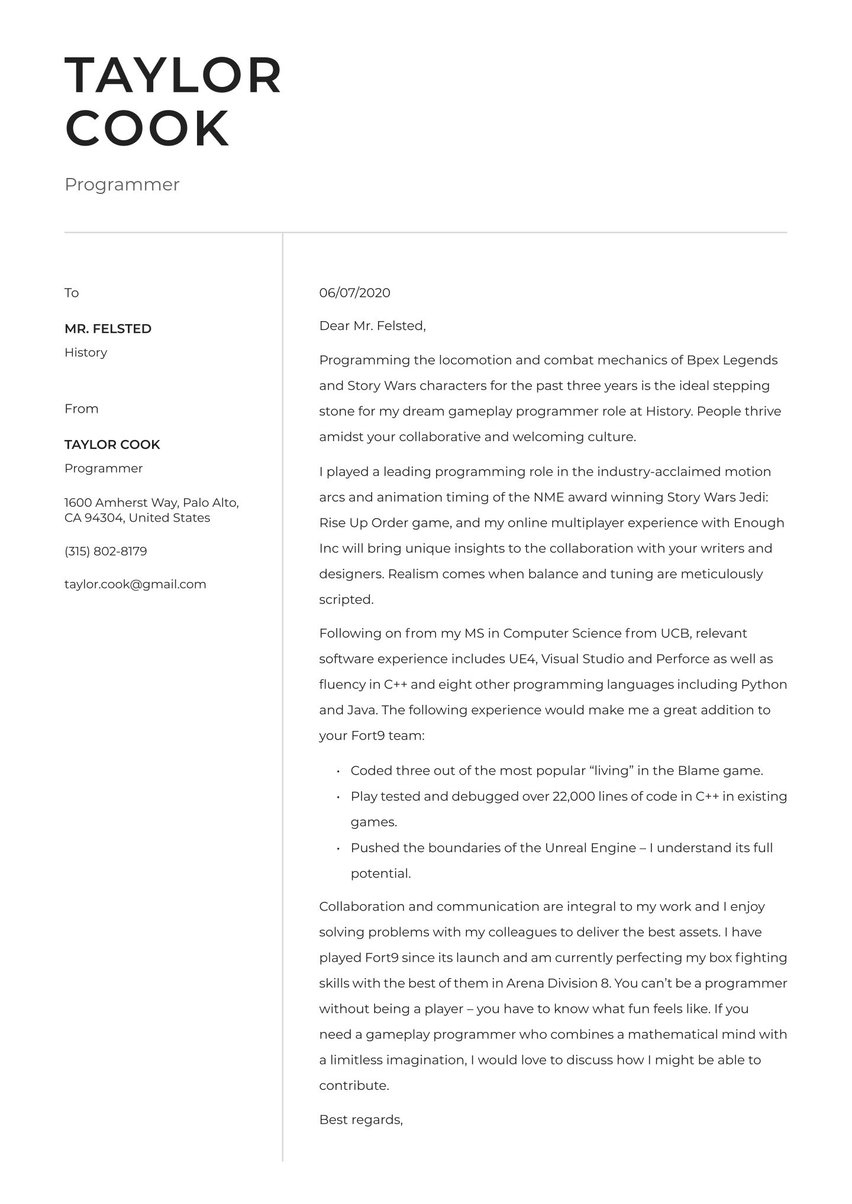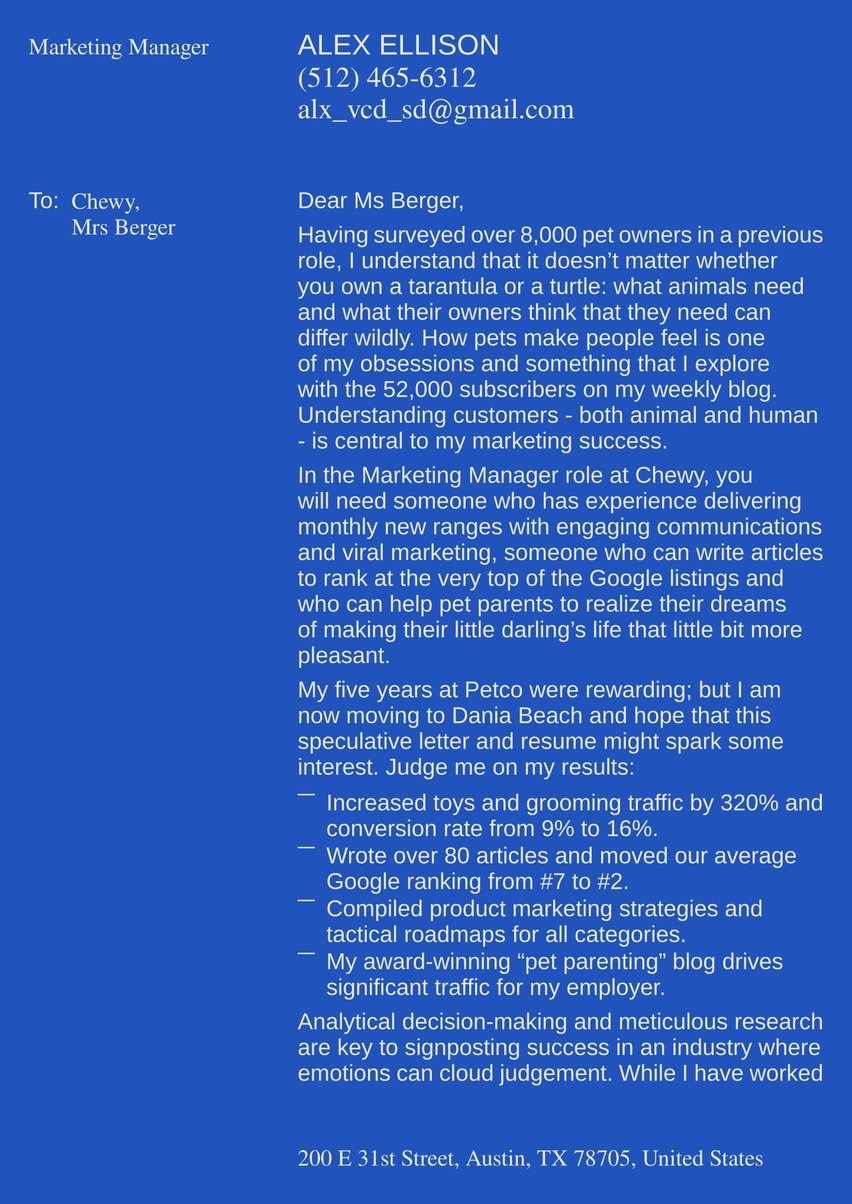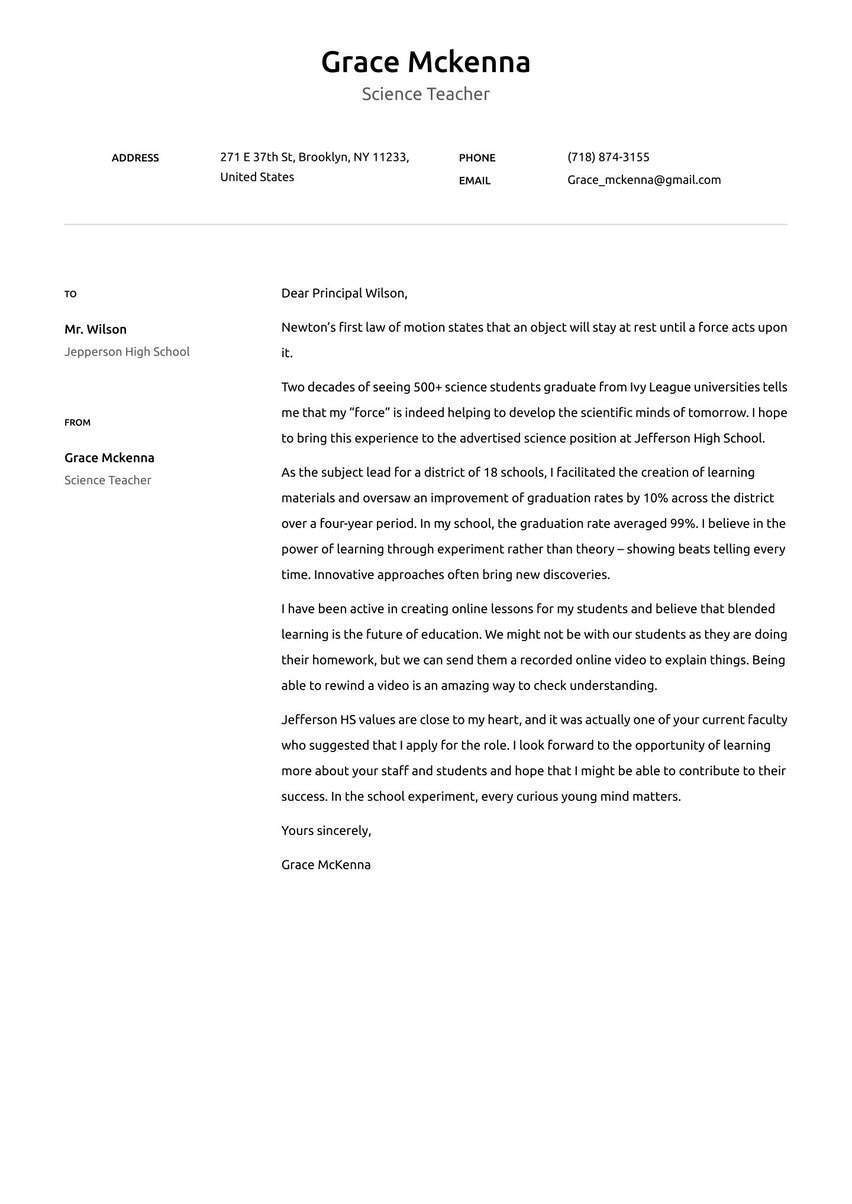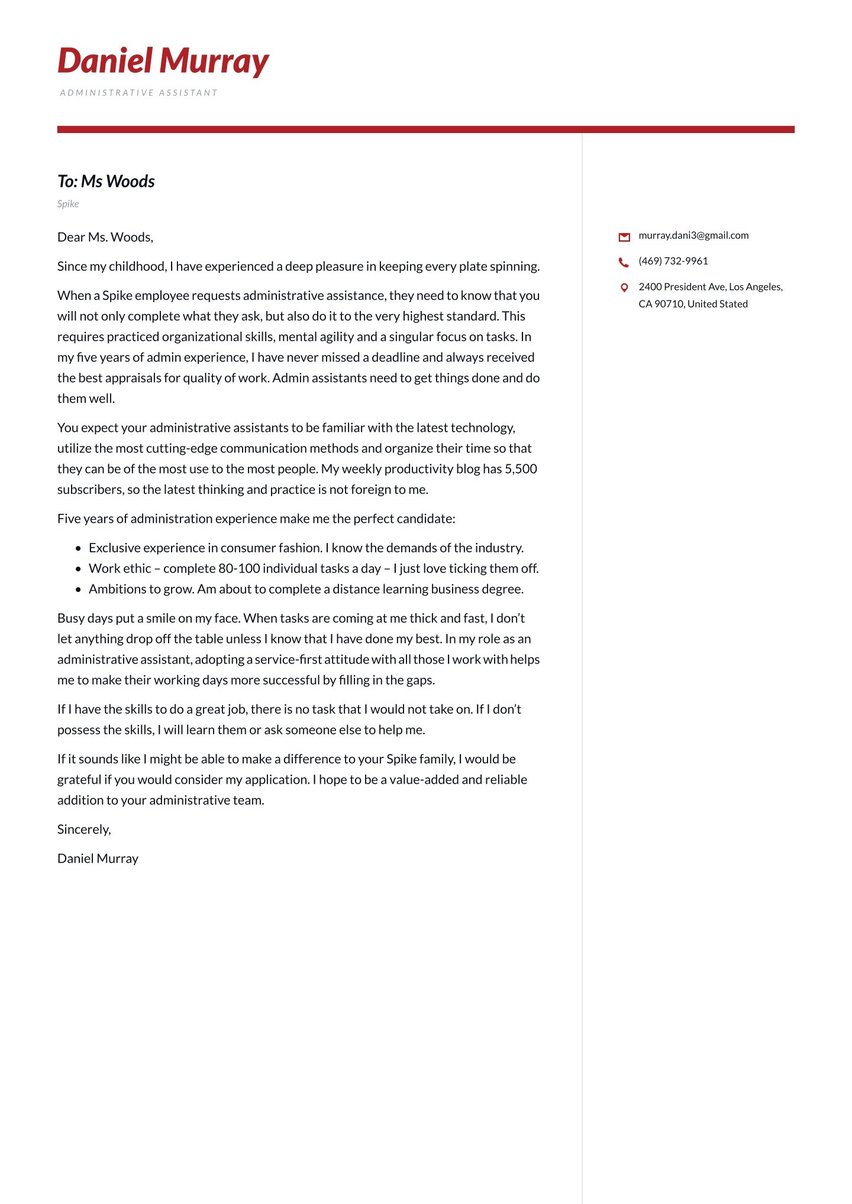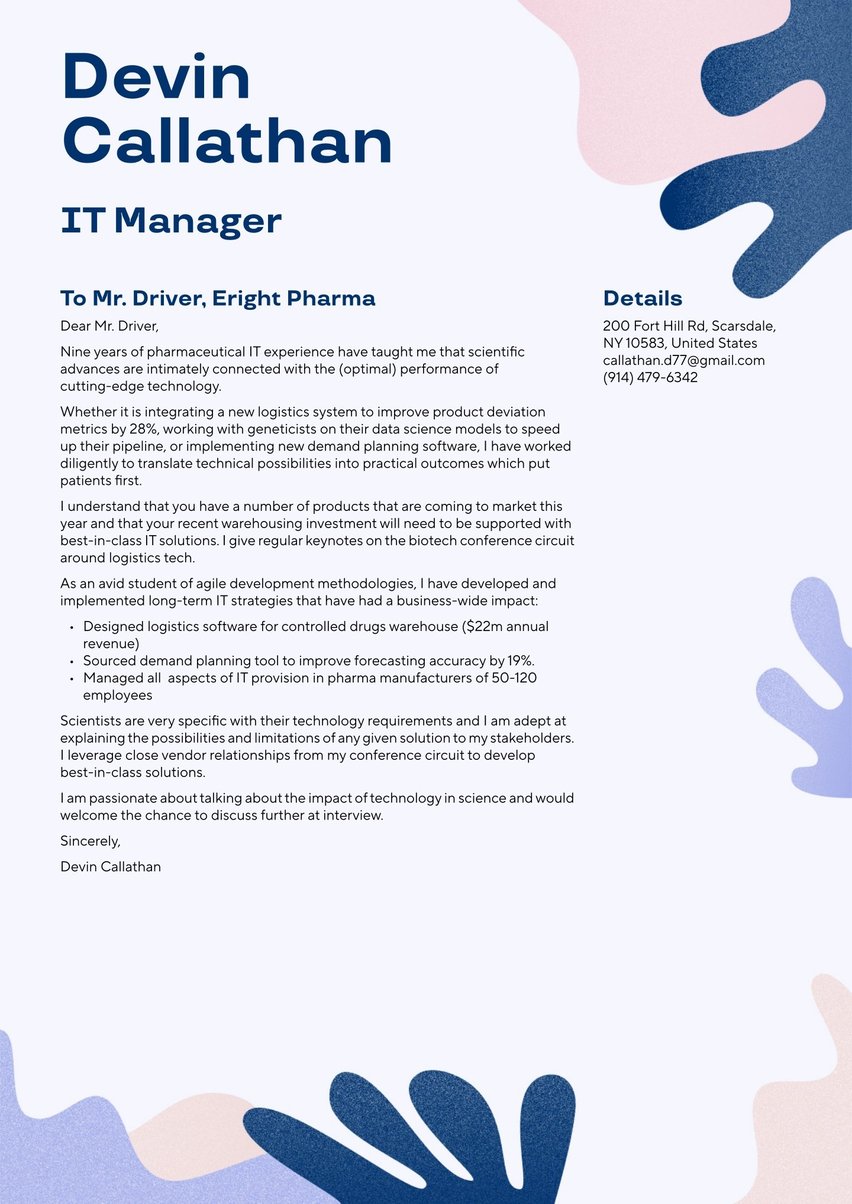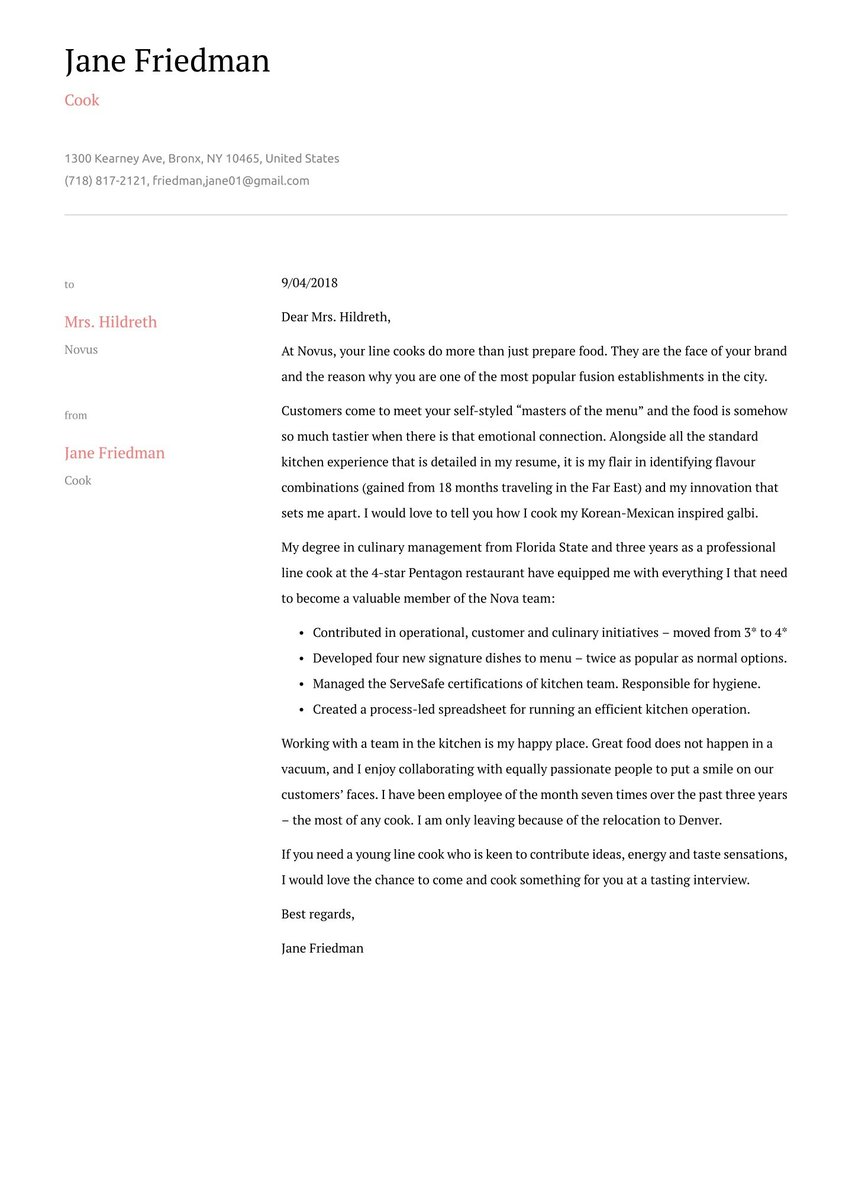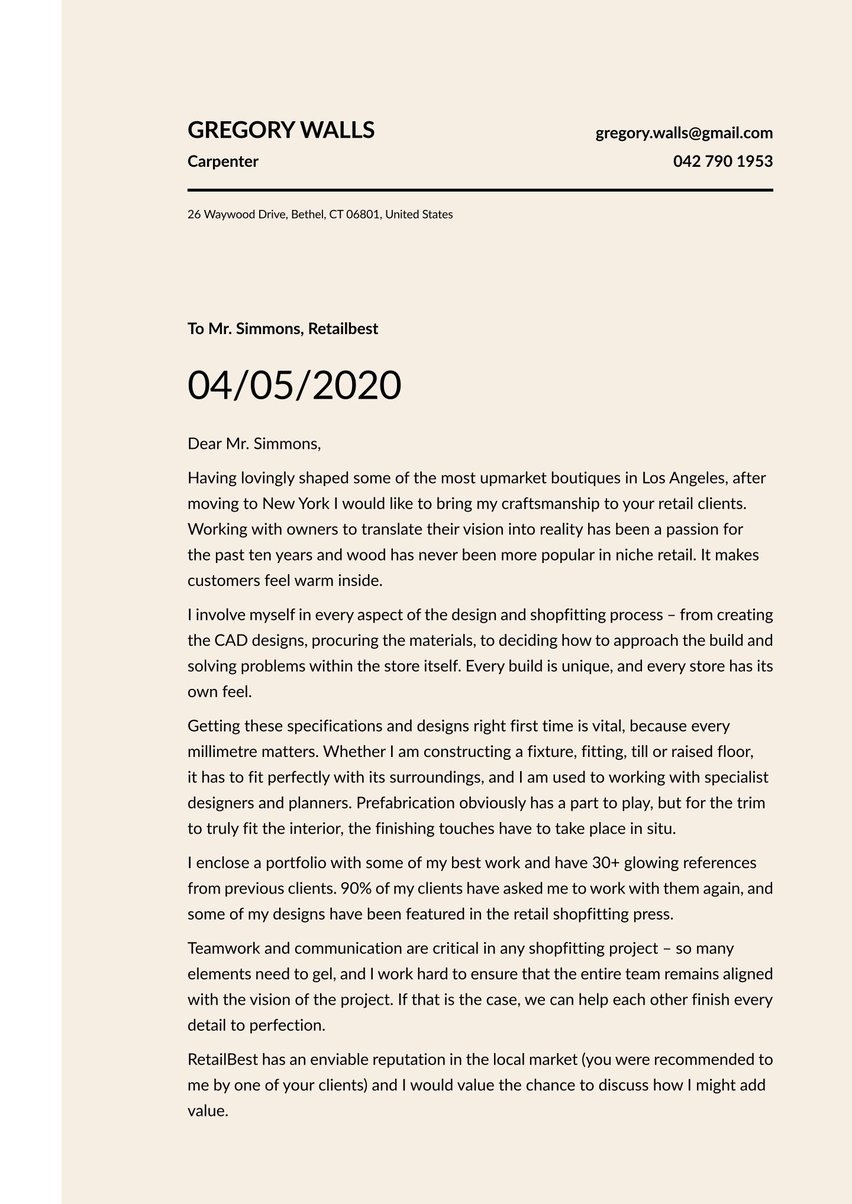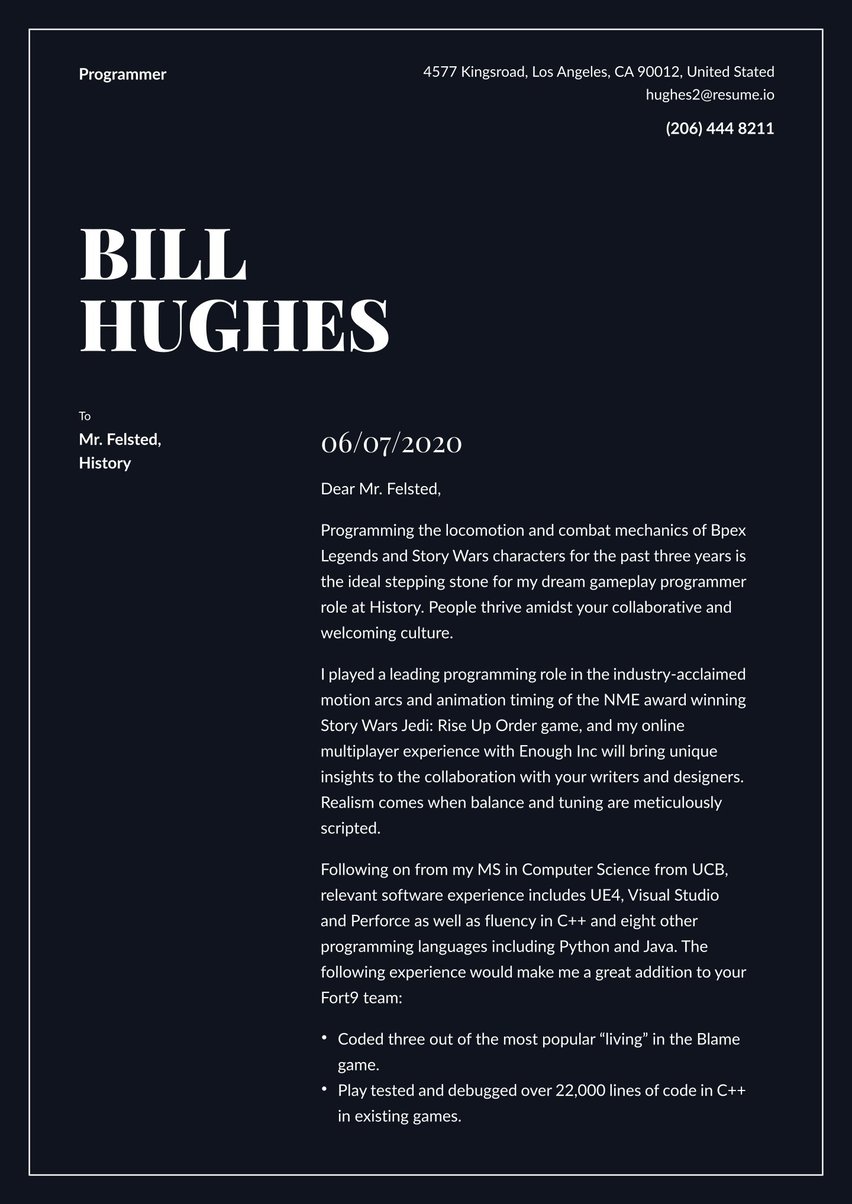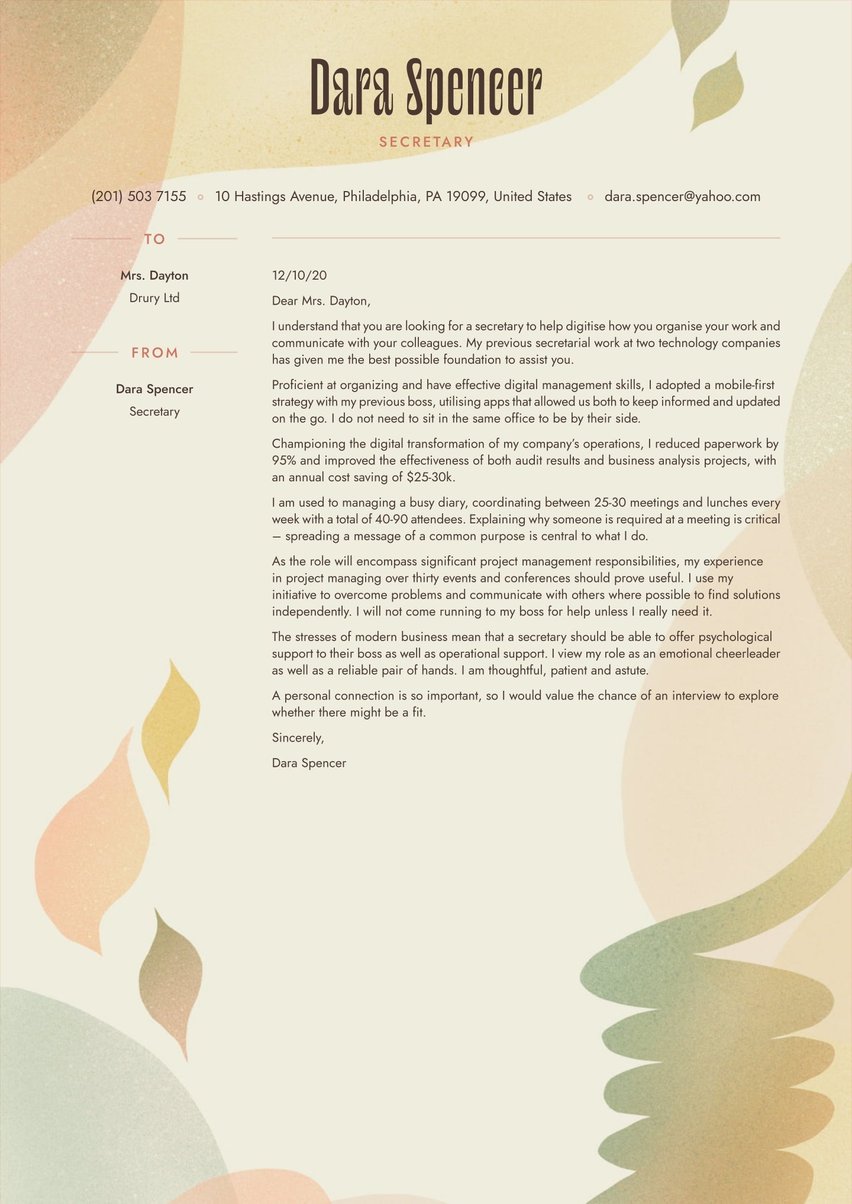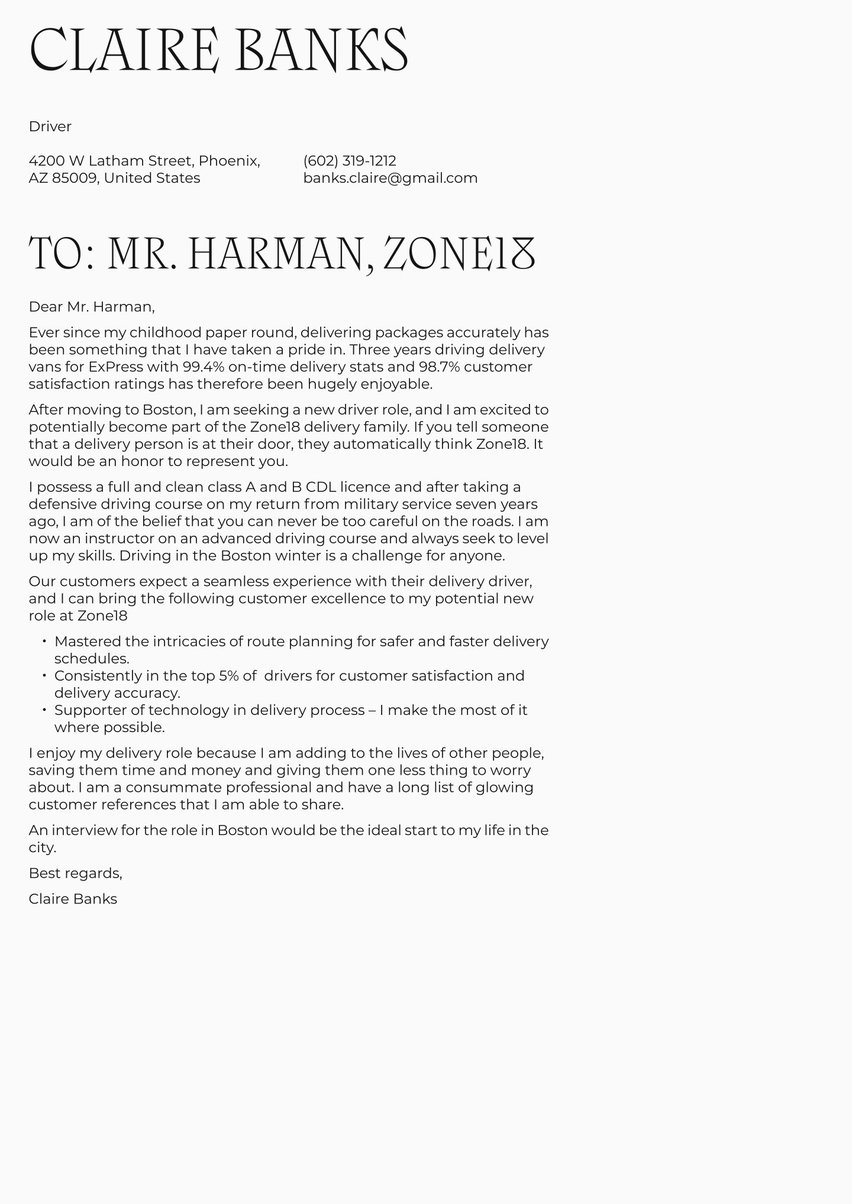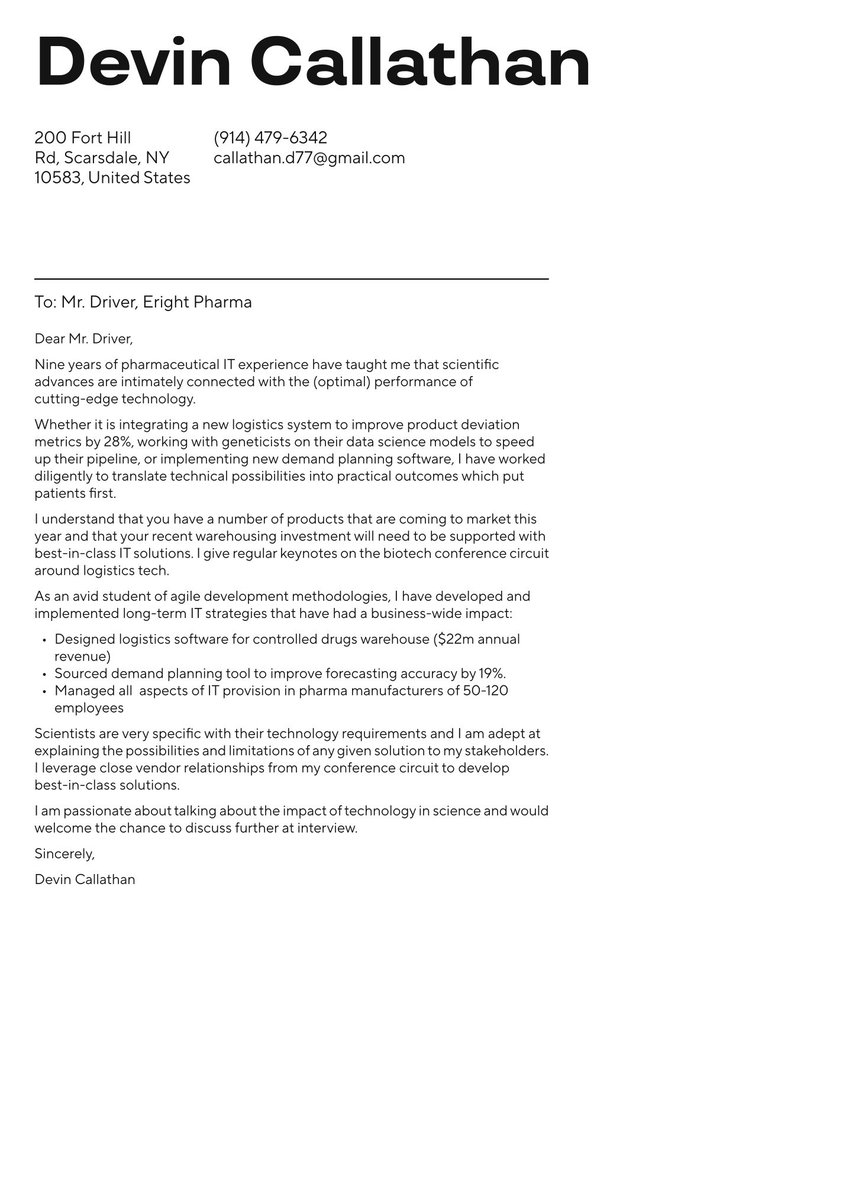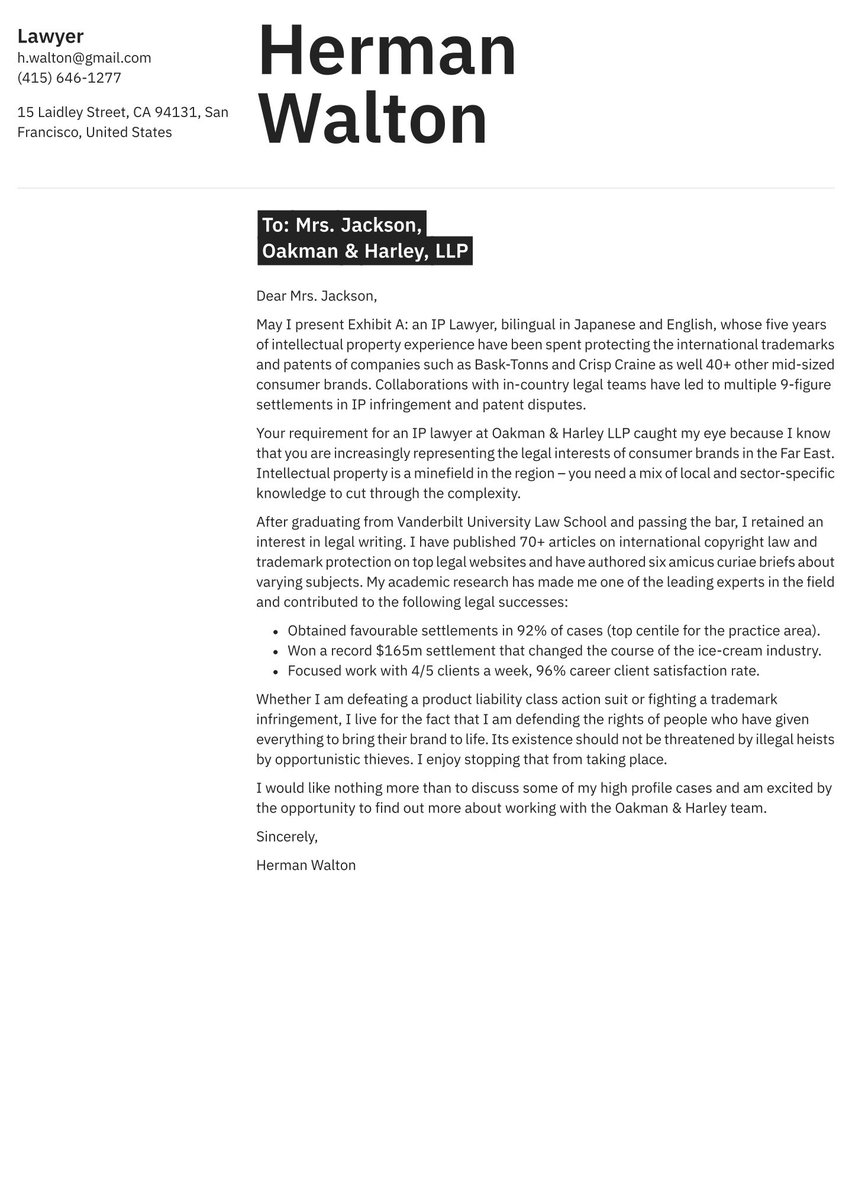Good leadership is vital to the success of any company or organization. Managers who are focused, goal-oriented and adept at motivating their employees can help propel a business forward in numerous ways.
Whether you already have extensive experience or you’re looking to land your first senior role, a professional cover letter is one of the best ways to show a recruiter you’re the type of candidate they’re looking for.
Since manager positions often come with better salaries, more responsibility and greater access to advancement opportunities, it’s understandable that competition for these jobs is high. To land your dream job and put yourself on the path to success, you’re going to need a stand-out application that highlights your strengths.
Luckily with Resume.io’s collection of resources, including free templates and our cover letter builder tool, you’ll learn the tips and tricks of creating a cover letter that makes your application shine.
This guide, along with our manager cover letter example will:
- Explain how a cover letter is vital to increase your chances of landing the position.
- Simplify the writing process by breaking it down into manageable subsections.
- Explore one of the most effective psychological writing tricks to use in every letter.
- Help your job application stand out by showing you which common mistakes to avoid.
Now it’s time to create a cover letter that separates your application from the rest.
Manager cover letter sample and writing tips
You’ve probably noticed that your resume doesn’t leave much room for personality or explanation, aside from a few lines of profile summary. And while it’s great for conveying important names and dates, that’s certainly not all you have to offer as a candidate.
That’s where your cover letter comes in. This 200 to 400 word document (or the length of one page), is perfect for expressing your most formative experiences and greatest achievements. Your cover letter allows you to create a personal connection and make a great first impression with an employer before ever setting foot in the door for an interview.
What if the job application DOESN’T require a cover letter?
Sometimes, a job posting won’t make mention of a cover letter or it will describe the document as “optional.” Is that a free pass to save yourself the effort of writing a cover letter?
If you’re serious about getting the manager job, then you should ALWAYS write and send a cover letter, unless the job posting specifically asks you not to. While others on the job search may take the easy way out, you’ll be putting yourself miles ahead of the competition by investing a bit of time to make a case for yourself as the right fit for the company’s next management position.
The perfect cover letter is all about maximizing your chances. Sure there may be dozens of other applicants, but if only a handful write a convincing cover letter, you’ve automatically put yourself in the final round.
While you need both a cover letter and a resume to land your next position, one of the cover letter's greatest advantages is that it helps to level the playing field. There may be other job seekers with more experience, but the heart and dedication you convey in your cover letter can quickly be what sets you apart.
Tailoring your cover letter for success.
Writing and submitting a cover letter is a start, but the truth is a bland cover letter just won’t cut it when the competition is fierce. Luckily, you can quickly polish a generic cover letter by tailoring it to each individual position you apply to.
That means doing a bit of background research about your potential employer. What are their goals? What is their mission? What can you learn about their workplace culture and internal organization? A solid base understanding of the company and their needs can help you effectively convey your potential contributions if you were to land the role.
You should also tailor your cover letter with the statistics, numbers, and facts that backup your achievements as related to the company’s needs. The goal is to show – without being presumptive – that you can make a difference based on your proven track record.
If you're looking for more ideas before you get started, look to our other Business & Management cover letters:
- Business Analyst cover letter sample
- Executive cover letter sample
- Project Manager cover letter sample
- Product Manager cover letter sample
- Consulting cover letter sample
- Project Coordinator cover letter sample
- Executive Assistant cover letter sample
- Supervisor cover letter sample
- Assistant Manager cover letter sample
- Business and management cover letter sample
- Program Coordinator cover letter sample
- Brand Manager cover letter sample
- McKinsey cover letter sample
- CEO cover letter sample
- Store Manager cover letter sample
- Quality Assurance (QA) cover letter sample
- Business Development Manager cover letter sample
Best format for a manager cover letter
The time you invest in writing a great cover letter will pay you back twofold. First, it will help you to land your desired position, but secondly, the more cover letters you create, the faster and more effectively you’ll be able to write them. Since cover letter structure remains relatively unchanged between positions and industries, this skill can benefit you for the rest of your career.
Here are the key components of a cover letter:
- The cover letter header
- The greeting / salutation
- The cover letter intro
- The middle paragraphs (body of the letter)
- The ending paragraph of your cover letter (conclusion and call-to-action)
You can learn more about each of these sections and get writing tips and examples in our overall guide on cover letters.
The comprehensive cover letter guide offers more general advice about how to go about compiling cover letters, but below you will find specific advice on how to maximize the effectiveness of each specific letter paragraph and section.
This manager cover letter example is a good foundation to develop your own professional application:
Dear Ms. Cass,
Helping parents make the best purchase for their little ones is an incredibly rewarding career. People stay 30% longer in the baby section because they need advice. Analysing customer flow patterns and product sales data, I estimate that over the past thirteen years, I have helped over half a million.
That is a lot of baby chat, fuelling an average 15% annual sales growth.
Coming into a store is so much more worthwhile than shopping online. This is the battleground for any retailer that wants to gain market share. There will always be parents who need reassurance about their purchases. When they are with you in the store, they are primed for all sorts of add-on purchases. I have no qualms in persuading people to buy better products for their children.
I understand the rigours of big box retail and would love to tell you about my awards for operational excellence. My merchandising has been featured in the retail press – parenting solutions should be on display.
My commercial experience would serve me well at Kidmart.
- Consistently exceeded profitability targets. Best year +22%.
- On shelf availability averaged 99.3% - consistently beating budget.
- Promotional success with countless supplier exclusives.
Managing varying sized teams of sales associates has taught me the value of a cohesive target-led working environment. Every sale should be celebrated. I cannot abide working with people who don’t care and try to ensure that my own passion is as contagious as possible.
I became aware of the role from your department manager Harriet Norman, so I have an insider understanding of your culture. I would welcome the opportunity of an interview to discuss how I might fit in.
Sincerely,
Grace McKenna
Cover letter header
In medium to large companies, hiring is often done by a team of HR professionals. This means that your application is likely to float from desk to desk while multiple people review it. The main purpose of your cover letter header is to ensure that no matter who comes across the document they know it belongs to you and how to get in touch should they want to set up an interview. Make sure to include only the necessary personal data like your phone number, email address and LinkedIn.
The secondary purpose of your cover letter is to provide an attractive design and keep your name front and center.
The goal of this section: Identify your cover letter as belonging to you and keep your phone number and email address at the hiring manager’s fingertips, create attractive formatting so that your document catches the employer’s attention.
Align document styles!
One of the best things you can do to create a polished and professional application is to align the document styles of your cover letter and resume. This will help to create a “personal brand” – a consistent look and feel that visually identifies the document as belonging to you.
The header is one of the few places you can add color or other design elements to an otherwise bland sheet of paper. Before choosing a style, however, it’s a good idea to take into account the branding of your potential employer. Are they fun-loving and casual or do they seem to take themselves quite seriously? A few minutes spent poking around their website and social media feeds can help you make the determination.
Once you’ve got a good idea of what color palette and designs would best fit the feel of the company, you can create a header for your documents. If you’re a graphic designer you can do this yourself. If not, professional formatting tools can help. Check out Resume.io’s collection of easily customizable templates to create an attractive and cover letter and resume in just a few clicks.
Cover letter greeting
Your greeting is one of the most important ways you can establish a personal connection and a respectful tone right from the start. Choose the greeting that’s most appropriate for your potential workplace. “Dear” followed by the correct salutation and the last name of the letter reader works in almost all formal situations, but some companies prefer more casual communication like “Hello” or even a first name. Our cover letter example goes with "Dear" to be on the safe side.
The goal of this section: Establish rapport with the letter reader by addressing them with the appropriate greeting and by using their name.
The importance of names and addressed greetings.
It’s been scientifically proven that we have a positive neurological response upon hearing our own names. Monogrammed key chains and towels have been capitalizing on this fact for years – and you should too – in your cover letter, of course!
Using the name of the hiring manager or other person most likely to read your letter is a great way to show you’re truly interested in the position and you’ve done a bit of research to make a great impression.
However, in some medium to large companies, hiring is handled by a team of people. Even if you were to find their names, it’s unlikely you’ll be able to tell exactly who will be reading your letter. Instead of addressing the wrong person, opt for a collective greeting with the company name like “Dear XYZ Company Hiring Team,” or “Dear Hiring Manager.” These options are much more effective than the impersonal “To Whom It May Concern.”
Cover letter introduction
Hiring managers are busy people. Your cover letter introduction is your chance to grab their attention and increase the odds that the reader will finish your letter. It’s a good idea to include the name of the position you’re applying for, but avoid bland introductions at all costs. An interesting anecdote, relevant fact or exciting statement are all good options to create a captivating and memorable cover letter.
The goal of this section: Pique the hiring manager’s interest right from the start by using an anecdote, fact or other exciting statement to create a bold introduction.
Our cover letter example text leaps right into statistical details of the writer's achievements.
Dear Ms. Cass,
Helping parents make the best purchase for their little ones is an incredibly rewarding career. People stay 30% longer in the baby section because they need advice. Analysing customer flow patterns and product sales data, I estimate that over the past thirteen years, I have helped over half a million.
Cover letter body
The body of your letter is where you can finally explore all the achievements, skills and milestones that make you a great fit for the position. While you’ll want to avoid a presumptive or arrogant tone, there’s no need to be shy about highlighting your strengths since the whole purpose of this section is to make the best case for yourself.
To make the writing process easier, you can break down the body into two subsections. In the first, you can use the STAR method to describe a Situation, the Task required, your Action and the positive Result you achieved.
In the second section, you can expand upon your management skills and potential contributions to the employer allowing them to imagine the benefits you’d bring to their company.
The goal of this section: Use specific, relevant examples to show off your variety of skills and potential contributions to the employer.
Our manager cover letter sample body text uses a bulleted list to break up the blocks of type and highlight successes.
That is a lot of baby chat, fuelling an average 15% annual sales growth.
Coming into a store is so much more worthwhile than shopping online. This is the battleground for any retailer that wants to gain market share. There will always be parents who need reassurance about their purchases. When they are with you in the store, they are primed for all sorts of add-on purchases. I have no qualms in persuading people to buy better products for their children.
I understand the rigours of big box retail and would love to tell you about my awards for operational excellence. My merchandising has been featured in the retail press – parenting solutions should be on display.
My commercial experience would serve me well at Kidmart.
- Consistently exceeded profitability targets. Best year +22%.
- On shelf availability averaged 99.3% - consistently beating budget.
- Promotional success with countless supplier exclusives.
Managing varying sized teams of sales associates has taught me the value of a cohesive target-led working environment. Every sale should be celebrated. I cannot abide working with people who don’t care and try to ensure that my own passion is as contagious as possible.
How to close a manager cover letter (conclusion and sign-off)
Now that you’ve finished discussing all your selling points, it’s time to finish off the letter strong with a great conclusion and signature. To encourage a hiring manager to contact you, try creating a Call to Action. This sentence expresses your enthusiasm for the position and invites the hiring manager to get in touch. You can also leave your phone number and email again here, space permitting.
Then, finish the letter with the appropriate signature. “Best regards,” “Sincerely,” or even “Thank you” in less formal situations can all work well.
The goal of this section: Create an effective Call to Action that encourages the hiring manager to contact you, sign off with the appropriate closing.
I became aware of the role from your department manager Harriet Norman, so I have an insider understanding of your culture. I would welcome the opportunity of an interview to discuss how I might fit in.
Sincerely,
Grace McKenna
Writing psychology – cover letter tools and strategies
As a manager, there are a few key qualities you’ll want to convey in your cover letter.
Communication: Managers need to have clear and effective communication skills, both written and oral, with customers and employees alike. Examples of times when you communicated the company position with positive results can help hiring managers envision what kind of asset you’d make to their workplace.
Initiative: Strategic thinking and the ability to step up when needed are essential skills for managers at any level. Times when you took responsibility or picked up the slack can really show how you invest yourself in the success of the company.
Confidence: As the manager, it’s your job to delegate tasks and handle big issues. Confidence in decision-making and communication can go a long way to keep projects and teams running smoothly.
Problem-solving: In any potential management job, you’ll likely be asked to handle problems that arise while implementing larger strategies. Examples of times you made game-time decisions or used your best judgment can help show a potential employer that you’d make a dedicated and effective manager.
In my most recent assistant manager role, I was responsible for 8 associates per shift. I created a system of delegating precise, manageable tasks at the top of each hour to make sure my store was continuously organized and progress was made throughout the day. Under my leadership, we increased sales by 5 percent over four months and were recognized with the Teamwork Award by regional management.
Now check out the same example but without any concrete facts or numbers.
In a previous store manager role, I was responsible for several associates per shift. I made sure we all worked together to keep the store clean throughout the day. Under my leadership, we increased sales and were recognized by regional management.
Can you see the difference a handful of well-placed details can make?
Common mistakes with a manager cover letter
Here are some pitfalls candidates for manager positions often run into:
Generic letters: It might seem easiest to write one catch-all letter that can be used for a variety of companies, but that’s certainly not the best way to land a position. Make sure to tailor your letter to each company with the right names, facts and examples that make the best case for you in that specific role and workplace.
Formatting errors: Formatting should never be an afterthought. Be sure you have the right fonts and sizes with a good balance of white space to text. Professional formatting tools like Resume.io’s templates and cover letter builder can make this process much easier.
Grammar and spelling mistakes: For a role that requires excellent communication, typos and writing mistakes make you look sloppy and unprofessional. Use spell check, or better yet, have a friend proofread your cover letter before you submit.
Poor tone: It can be difficult to find the right balance between confidence and modesty, but it’s important that a cover letter for a manager conveys authority and vision. If you struggle getting the tone just right, it might be worth asking a friend to help, or check out our collection of pre-written example sentences inside of our free cover letter templates.
Key takeaways
- A professional cover letter is an essential part of a complete and effective application. Unless an application specifically asks you NOT to include one, it’s always a good idea to create the best case for yourself by writing a thoughtful cover letter.
- Maximize your cover letter’s chances of landing you the position by tailoring it to each employer and job description you apply to. Make sure to choose relevant anecdotes and facts to convey your potential contributions.
- The tried-and-true cover letter structure works across almost all positions and fields. Follow it to simplify the writing process.
- Specific facts, numbers and details are the best way to show your success and convey your effectiveness as a manager.
- Don’t fall into the trap of writing a great letter with poor formatting. Use professional tools like Resume.io’s templates and cover letter builder to make a great impression from the start.
With resume.io, you can create a perfect cover letter in just a few minutes. No uncertainty, no hassle.


